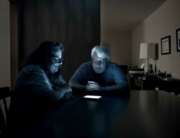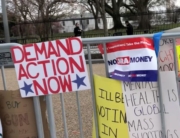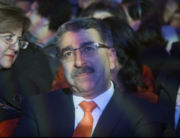
The journalist group Videofreex in the Catskill Mountains in Here Come the Videofreex (Long Shot Factory)
Small, portable cameras made possible the early video revolution in journalism, first with the Sony Portapak in 1967. Here Come the Videofreex goes beyond oral and written histories to retrieve, preserve, and showcase the essential visual history of a key group in the lively experimentation outside of broadcast television. With changing technologies, people’s memories are now more accessible than 45-year-old footage shot in an obsolete half-inch format that was prized for immediate dissemination, not for archives.
Directors Jon Nealon and Jenny Raskin tracked down the members of the New York collective Videofreex, whose members learned to combine techie tinkering skills with counterculture lifestyle and politics. The directors found boxes of their unmarked or incorrectly labeled tapes and, after more than a decade working with the specialists at DuArt video production services, were able to restore material that vibrantly captures a new method of collecting news and the people who were changing the definition of news.
So it’s a surprise to find out how in 1969 a group of hippies interested in the new technology, but with no regular access to the equipment, were given a budget and cameras by the CBS network. The network consultant charged with finding people who could report on the counterculture beat from the inside found out about the group’s downtown showings of footage they’d taped at the Woodstock Festival, where several pairs and threesomes of the 10 young co-founders, barely older than 18, first teamed up. While the networks were looking at the traffic jam from the copters above and at the big name acts on the stage, the young journalists covered the audience by developing an interview style to gain “the kids” trust (who worried “Are you with the CIA?) and insights. (Says a long-haired dude stroking a lamb: “I came for the evolution.”)
Don West, who still comes across like The Suit from CBS, was the assistant to network president Frank Stanton when he got the idea to oversee a series on what was going on across the country among the antiwar protesters and on campuses—that no network was covering. So the 10 piled into an RV with the latest gear and headed across the country. Beyond talking to high school and college students, they taped notable movement figures appearing in their first TV interviews. Abbie Hoffman, at Yippie headquarters in Chicago, worried about how he could keep his organization from financially falling apart, and Black Panther Fred Hampton justified the Panthers’ justification of self-defense just weeks before he was shot dead by law enforcement.
CBS finally gave them a deadline, and they had to figure out how to edit, not something they’d ever done before. But the screening for CBS executives was a disaster, and not only was the series idea cancelled but West lost his job: “I watched my life go down the drain.” (Don’t worry, though not mentioned here, he went on to an acclaimed career as managing editor of Broadcasting.) The Videofreex, however, gleefully recall that they still had their CBS employee badges and used them to liberate their tapes and get supplies. Their downtown showings of the rejected footage were “packed.”
The co-founders describe how their roles evolved, including David Cort as the interviewer, Carol Vontobel learning accounting, Bart Friedman attempting to be businesslike, and so on, as they covered what they considered the important events of 1970 and 1971 not seen in the mainstream media. The women co-founders are particularly proud of such documentation as the Women’s Strike for Equality and the abortion consultations at the Women’s Medical Center, where they couldn’t help but get drawn into the filmed confessions. (The directors got permission to include this sensitive material). At the May Day protests against the Vietnam War in Washington, DC that attempted to shut down the city, the cameraman convinced police to let him hold on to his equipment, and he kept taping in jail during a roundup of activists. (About 12,000 were arrested over several days.)
A new chapter of innovation began when the New York State Council on the Arts offered the group a major media grant if they moved upstate to provide training workshops. Given the money, apartment, and interpersonal woes that were exacerbating friction in downtown Manhattan, Videofreex settled in the idyllic Catskill Mountains. The interviewees, whose identifications are not repeated enough to track, go on about their interchanging love affairs, childbirths, and other personnel changes. Against these anecdotes is a funny tale of them figuring out how to set up a transmitter and program for a pirate TV station, where network reception wasn’t possible (just the kind of rural situation cable TV was first supposed to serve).
Locals fondly remember how the hippie commune got them to go before the camera and how they used to watch their neighbors on the micro-level of news: car accidents, farm reports, and a kids’ talent show. Since Videofreex reused tape again and again, the directors were lucky to retrieve this footage, a model of the localized media yet to come. The archival preservation process continues.
Unfortunately, the documentary does not conclude with the usual “Where are they now?” scroll, which would have shown how this experience greatly influenced most of the team to continue in media arts, from the radical to the mainstream. Anyone interested in how the revolution was televised will want to see it here.






Leave A Comment